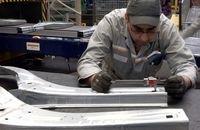Audit success for Somaca and Avtoframos brings ISO 14001 certification to 100% of Renault industrial sites
ISO 14001: international certification
ISO 14001 certification (by the International Organization for Standardization) attests to a site’s commitment to continually improve its environmental management and reduce the ecological impact of its operations. Certification is issued on successful completion of an in-depth audit by independent accredited organizations (UTAC1 and SGS2, for Renault sites). The certification procedure involves several stages, starting with:
- In-the-field analysis of environmental impact - Definition of objectives and targets - Implementation of a regularly audited progress plan
This procedure presupposes that all site personnel are properly informed and fully mobilized. To progress in environmental management, Renault carries out yearly internal site audits consistent with the ISO 14001 standard, merging specialist input from both site personnel and environment experts. This strengthens site personnel skills in environmental matters and stimulates networking across different sites.
Ten years of environmental management certification
Sandouville was the first Renault site to achieve ISO 14001 certification, back in December 1998. The same year, the powertrain plant at the Ayrton Senna complex in Brazil was designed to work under zero-industrial-discharge conditions, thus protecting the site surroundings, 60% of which are considered protected biodiversity areas.
Whenever Renault sets up a plant in a new country, it pays the greatest attention to economic, environmental and social development. A good example is the Pitesti site in Romania, which was consolidated under the Renault group in 2002 and obtained initial ISO 14001 certification in 2005. Somaca in Morocco was consolidated in 2006, and the site obtained ISO 14001 certification in early 2008. Substantial human and material investments have been made here to reduce the environmental impact of operations. A new physical-chemical industrial effluent treatment plant will be started up at Somaca in 2008. Another significant example is the global waste management system, compliant with European standards, set up in 2007. And action plans on the manufacturing system brought energy savings per car of 15% in 2006 and 22% in 2007. The AvtoFramos site in Russia came under Renault group consolidation in 2005 and became the last Renault group to obtain ISO 14001 certification, in April 2008. Efforts here focused primarily on personnel education in environmental matters.
Grassroots efficacy for environmental management system
Environment issues take a central place in the Renault Production Way. As early as 1995, Renault set up an environmental management system. It applies to all sites worldwide, but factors in the local specificities at each plant. The main feature of this system is that it is based on a group-wide network of ecology correspondents.
The originality of Renault’s environmental management system is that it involves teaching ecological principles to personnel in each manufacturing function, rather than teaching industrial processes to environment specialists. The result is a network of around 600 correspondents across all sites (18 different functions and 14 different countries). This arrangement is highly conducive to information and skills interchange.
Best environmental practices are effectively propagated throughout the group, collective skills are developed, and a culture of ecological responsibility is gradually built up across the whole workforce.
Conclusive results
Environmental management at Renault sites has yielded the following results over the last ten years:
Coherent, auditable management system
In 1999, Renault introduced formal audits to check data on the environmental impact of its industrial sites, along the lines of its financial audits. With its robust reporting system, driven by a well-structured environment network and strong commitment from people at head office and individual sites, Renault obtained very reasonable audit ratings from the outset. Indeed, Renault is among the highest-rated companies for good environmental reporting practices at national and international level.
Renault ecoČ
In 2007, Renault launched the Renault ecoČ signature to identify and promote its line-up of economical and ecological vehicles. To earn the Renault ecoČ badge, a car must meet three criteria. First, it must emit under 140 grams of CO2 per km (or run on biofuel).
Second, it must be made at an ISO 14001 certified plant. Third, at least 5% of its plastics content must be sourced from recycled materials, and the end-of-life utilization rate must be at least 95%. Renault ecoČ vehicles are ecological in terms of measurable results throughout the vehicle lifecycle. They are economical in terms of fuel consumption and affordable technologies. Commitment on respect for the environment extends across the whole of the Renault workforce, to achieve progress that is tangible across all customers. Economy and ecology go hand in hand, to ensure massive-scale reductions in environmental impact. Environmental improvements are sought across the largest possible employee base, to make ecology-friendly products for the largest possible customer base.



